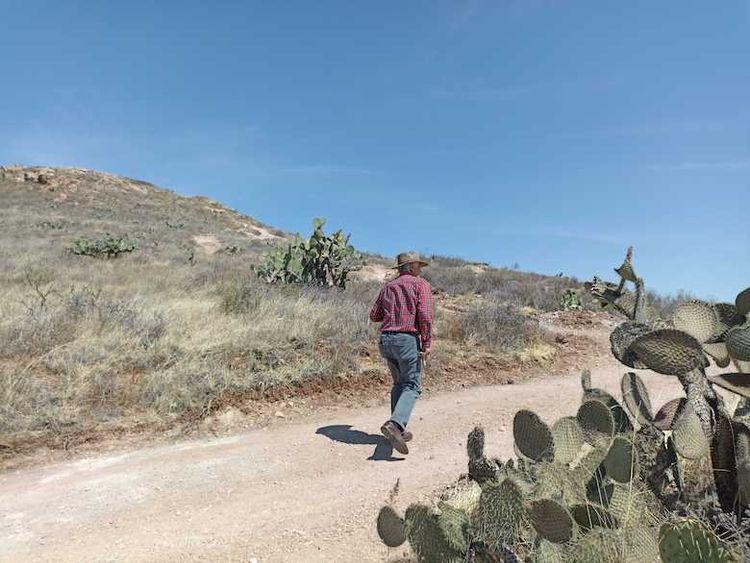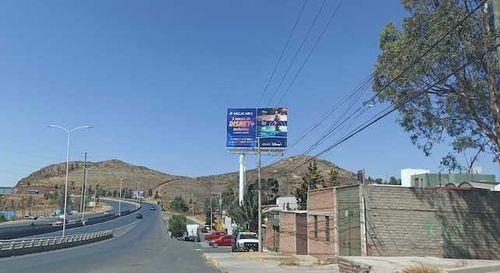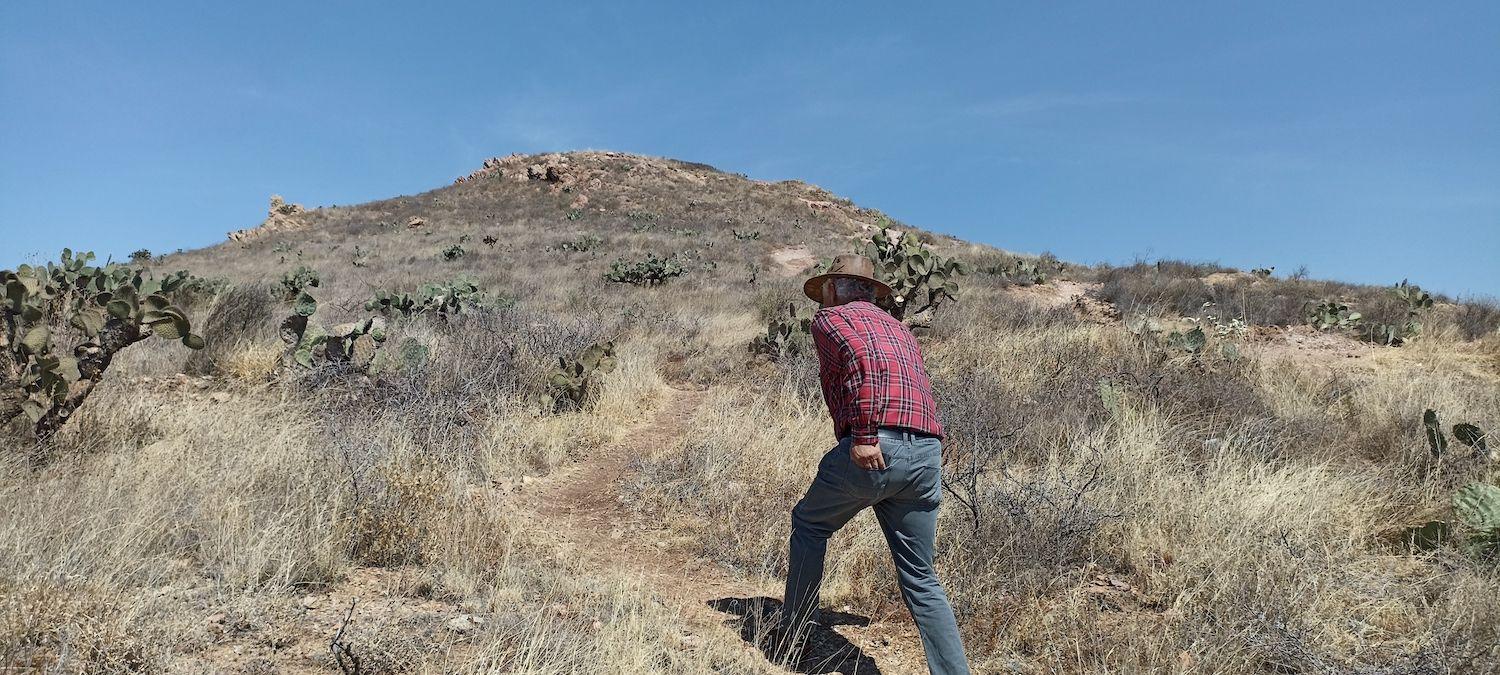Don Roberto Sánchez climbs steadily to the top of Cerro del Padre in the city of Zacatecas, his 75 years are not a problem, as he is a country man. Standing on the side of a cross, it points to the west side of the slopes of the hill, towards the La Encantada subdivision. “That's where they want to lotify,” he says.
In the designated site, the area with the most vegetation, there are white marks that delimit properties, so that the urban stain continues to grow.
The Cerro del Padre, a 2,505 meter high hill, is one of more than eight hills located near the urban area of the city of Zacatecas. All are part of the Central Plateau, a natural region located between the Sierra Madre Occidental and the Sierra Madre Oriental, which borders the Neovolcanic Axis to the south.
“We want this to be preserved, we are fighting so that it doesn't get urban,” says Roberto Sánchez.

Photo: Alejandro Castro/ Causa Natura Journalism
The still small environmental community of Zacatecas requires the preservation of the site, which in addition to being a natural heritage, is part of the biocultural corridor of the Wixarika community's route to Wirikuta, in San Luis Potosí, the most sacred territory in its cosmogony. It is a set of roads and sidewalks with around 16 points considered sacred along a route of more than 400 kilometers.
Roberto Sánchez, who owns an old bookstore in the city center, is a well-known promoter of the Wixárika or Huichol culture. “It's important because of its nature and because it's a sacred place,” he says.
But there is a conflict that gives rise to the dispute over its conservation: more than half of the territory that makes up Cerro del Padre is privately owned.
The area where it is intended to be lotified is an upper middle class colony, with medium and large houses, located less than a kilometer from the Historic Center. “There are private interests, but they have to understand that collective interest is above collective interest,” says Roberto.
El Cerro del Padre has two protective decrees as a protected natural area.
The first originated during the term of former president Lázaro Cárdenas del Rio. On November 18, 1937, a decree was published in the Official Gazette of the Federation declaring a group of hills in the city of Zacatecas, including Cerro del Padre, a “Forest Protection Zone”.
“Only the use of dead wood for the purpose of preventing fires will be allowed in forest land covered by the Protected Zone, and cattle grazing will be subject to special measures,” the document states.
The Decree states that it is necessary to conserve the remaining forest vegetation, especially in places with extreme climates such as Zacatecas, whose forests were being overexploited “for the interest of a few”.
The second decree was published on December 5, 2009 under the management of the former governor of the state of Zacatecas, Amalia García Hernández. This is the “Ruta Huichola” State Park, which includes the municipalities of Susticacán, Jerez, Zacatecas and Guadalupe.
Although it does not specifically mention Cerro del Padre, the state park decree states that ceremonial sites, sanctuaries, religious and cultural elements and roads used by the Huichola community are subject to protection.
Right there, it states that the decree “safeguards the rights of property owners”.
The public-private dispute
Martha Ramírez Gallegos, former leader of the Mexican Association of Real Estate Professionals in Zacatecas, is the owner of the properties located next to the La Encantada subdivision.
Magdalena Beltrán Vázquez, head of the Government Secretariat of the municipality of Zacatecas, explained that the land located on Roberto Cabral Street, at the foot of the hill, was purchased by its current owner in 1992.
In April 2019, Martha Ramírez Gallegos obtained a Certificate of Urban Compatibility from the state government, through the state's Secretariat of Urban Development, Housing and Land Use. This document determines the feasible activities to develop a property or building.
However, this record had contradictions, Beltrán said.
On the one hand, it was specified that the use of land for housing was prohibited, but it gave rise to the possibility of building vertical housing.
Later, a group of neighbors filed a complaint on February 17, 2020 for the felling of trees on the property. However, the municipal administration of former mayor Ulises Mejía Haro had granted such clearing permits, Beltrán Vázquez said.
On March 23, 2020, the municipality of Zacatecas, through the Undersecretary of Urban Development and Territorial Planning, published a letter addressed to the settlers of the area, stating that it is not possible to grant permits to build or divide in the area.
After that, the State Department of Urban Planning and Development issued a new certificate of urban compatibility, in which, unlike the first, it cancels any possibility of construction.
This led to a contentious administrative proceeding initiated by the landlord, in order to annul this last evidence of urban compatibility and achieved the annulment.
The real estate entrepreneur once again requested a new certificate to build, but in February 2022, the landlord was notified of the land use restriction, stating that she can sell the land, but the person who buys it cannot build.
Magdalena Beltrán announced that a flora inventory has already been carried out and work is being done on the Manifesto of Intent to decree a Municipal Protected Natural Area (ANP).
They ask to increase legal protection
The Cerro del Padre, with a land area of 38.4 hectares, offers multiple environmental services to the population living in the area.
Luis Rahim Ruelas Vázquez, environmental engineer, who carried out an environmental characterization study of the hill in 2021, explained that among the ecosystem benefits it offers is the atmospheric regulation through vegetation; the roots prevent erosion, it is a refuge and breeding ground for species of endemic fauna and flora, in addition to its landscape beauty and biocultural value.

Photo: Alejandro Castro/ Causa Natura Journalism
Ruelas Vázquez's thesis suggests the formation of an ANP of municipal jurisprudence, but in an interview he proposes raising protection at the federal level, as part of the ecological reserves managed by the National Commission for Protected Natural Areas (Conanp).
According to the environmental engineer, who also works as a teacher, the environmental services offered by the hill are at risk due to various factors, including urban growth, forest fires and solid waste disposal.
Among the most representative vegetation of Cerro del Padre, according to Ruelas's study, are the Maguey Mezcal, the Gatuño, the Long-spined Biznaga, the Chilito Biznaga, the Tapón, Cardón and Duraznillo nopales and the Navajita grass, all endemic.
Among the fauna, the Tlacuache, Field Rat, Skunk, Hare, Habanera Pigeon, Woodpecker, Woodpecker, Sparrowhawk and Sparrow stand out.
“All of this needs protection, because it's not being taken care of,” Luis Ruelas said.
To resolve the public-private conflict in the area, Ruelas also brings to the table the possibility of generating income through the ANP rights collection scheme, which would allow landlords to make sustainable use and, at the same time, generate profits for the maintenance of the area.
José Antonio Gómez Barrón, environmentologist and researcher at the Zacatecan Council of Science and Technology (Cozcyt) supports the idea of improving the protection of the area, considering that there are enough technical elements to support the conservation proposal.
“There are business and real estate interests in the urban development of this area that should be protected. It is so identified, there is so much information from academic groups that place this site as being of environmental relevance to our state and to the preservation of the culture of the few remaining ethnic groups in our country,” concluded the academic.



Comentarios (0)